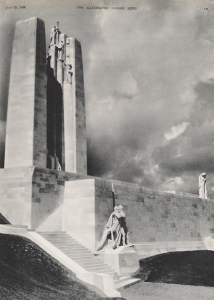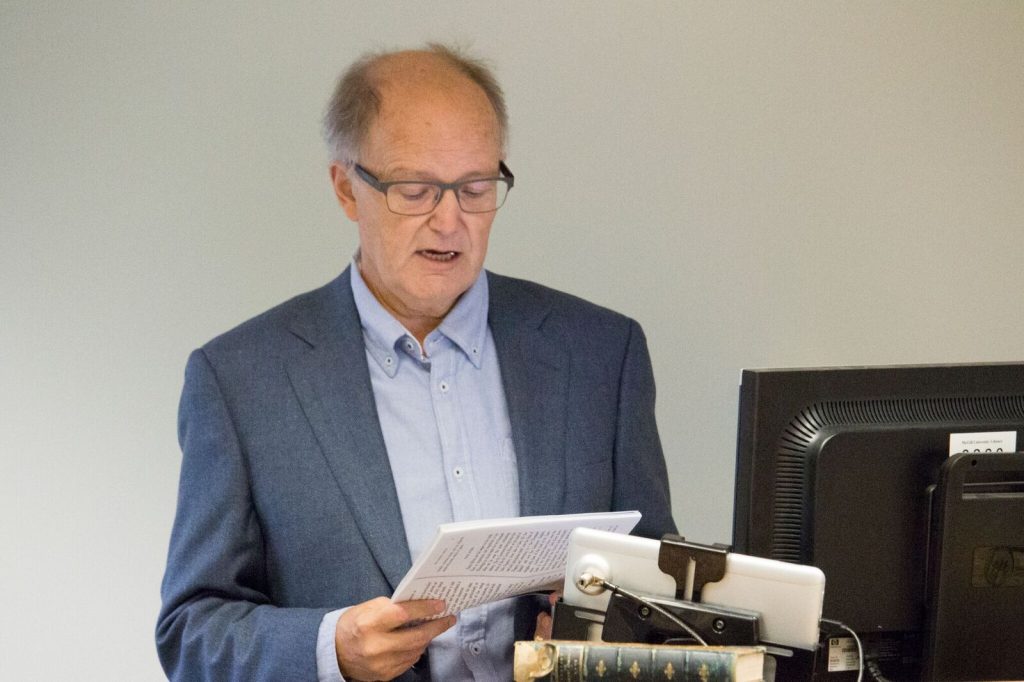
Design for Regina War Memorial Museum (unbuilt) by Percy E. Nobbs is included in Part II of the exhibition
By Richard Virr, Rare Books and Special Collections
La version française suit
The Great War (1914-1918) left a permanent mark on Canada, both as a nation and as a people. The country had experienced conflict, both abroad on the battlefields of Europe, where Canadian forces had been engaged since September 1914, and at home with the conscription crisis that engulfed the country in 1917 and resulted in a change of government. By 1919, Canada was a very different place from what it had been in 1914.

Headline History of the Great War, a scrapbook compiled by R.C. Featherstonhaugh, is included in Part I of the exhibition
On the Western Front in April 1917, the British army, including the Canadian Corps under the command of General Julian Byng, faced Vimy Ridge, a strongly-fortified seven-kilometre German defensive line in northern France. The military stalemate seemed unbreakable. Earlier French assaults on this position had resulted in over 100,000 casualties without breaching the German defences. Finally, Vimy Ridge was successfully stormed by the Canadian Corps in a three-day battle from April 9th through the 12th. The battle claimed the lives of 3,598 Canadian soldiers, with another 7,000 wounded.
The Battle of Vimy Ridge has become the embodiment of the Canadian experience of the Great War, and provided the inspiration for one of the most enduring images of the war in Canadian memory: the soaring cenotaph on Vimy Ridge. This memorial appears on the verso of our twenty-dollar bill.

Vimy Memorial, Illustrated London News, July 25, 1936, is included in Part I of the exhibition
This exhibition begins with Battle of Vimy Ridge itself and the memorial dedicated by His Majesty King Edward VIII in 1936. But it has another purpose: to explore how Canadians, in Montreal, at McGill University, and across the country, memorialized the bravery and sacrifices of its men and women during these years of war. Canada remembered by erecting cenotaphs and memorials in its cities, towns, and villages, and Canada remembers today every November 11th. Through objects, drawings, and photographs, these physical memorials are shown in their various stages of conception and realization. Though not all realized, these memorials are the aides mémoire of our national consciousness that served and continue to serve as markers of our national and communal life.
This exhibition will open in two stages: part I, devoted to the battle and the memorial, opened on Friday, April 7th and continues through November; part II, devoted to remembrance, will open on Friday, May 19th and continue to September 22nd.
The exhibition was curated by Jennifer Garland and Richard Virr, Rare Books and Special Collections, with the assistance of Lori Podolsky, McGill University Archives.
Se souvenir : Commémoration de la bataille de la crête de Vimy dans le cadre de son 100e anniversaire

Dessin conceptuel du musée commémoratif de la guerre de Regina (non construit) par Percy E. Nobbs, présenté dans le cadre de la seconde partie de l’exposition.
Par Richard Virr, Livres rares et collections spécialisées
La Grande Guerre (1914-1918) a laissé une marque indélébile sur le Canada, en tant que pays et en tant que peuple. Le pays avait connu des conflits, non seulement sur les champs de bataille en Europe, où les forces canadiennes étaient mobilisées depuis septembre 1914, mais également à l’intérieur de nos frontières où la crise de la conscription a secoué le pays, en 1917, et entraîné un changement de gouvernement. En 1919, le Canada était très différent de ce qu’il avait été en 1914.

Histoire de la Grande Guerre, album de découpures de grands titres préparé par R.C. Featherstonhaugh, présenté dans le cadre de la première partie de l’exposition.
En avril 1917, sur le front ouest, l’armée britannique, y compris le Corps canadien sous le commandement du général Julian Byng, se trouvait devant la crête de Vimy, une ligne défensive allemande puissamment fortifiée qui s’étendait sur une distance de sept kilomètres dans le nord de la France. Ce bastion semblait insurmontable. Les assauts précédents menés par les Français à cet endroit avaient entraîné la mort de plus de 100 000 soldats, mais n’avaient pas permis de percer la ligne défensive allemande. Finalement, le Corps canadien a réussi à s’emparer de la crête de Vimy au terme d’une bataille qui a duré trois jours, soit du 9 au 12 avril. Cette bataille a coûté la vie à 3 598 soldats canadiens et en a blessé 7 000 autres.
La bataille de Vimy incarne maintenant la participation du Canada à la Grande Guerre et elle a inspiré l’une des images les plus mémorables qu’ont les Canadiens de la guerre : le cénotaphe qui est érigé sur la crête de Vimy. Ce mémorial figure au verso de nos billets de vingt dollars.

Mémorial de Vimy, Illustrated London News, 25 juillet 1936, présenté dans le cadre de la première partie de l’exposition.
L’exposition commence par la bataille de Vimy elle-même et le mémorial offert au Canada par Sa Majesté le roi Édouard VIII en 1936. Elle présente aussi comment les Canadiens à Montréal, à l’Université McGill et partout au pays commémorent la bravoure et les sacrifices que les hommes et les femmes ont consentis pendant ces années de guerre. Le Canada se souvient grâce aux cénotaphes et aux monuments commémoratifs qui ont été érigés dans ses villes et villages, et au jour du Souvenir célébré chaque année, le 11 novembre. Par l’entremise d’objets, de dessins et de photographies, ces monuments sont présentés aux étapes de leur conception et de leur réalisation. Bien qu’ils n’aient pas tous vu le jour, ces monuments sont notre aide-mémoire collectif national et continuent de servir de marqueur au sein de notre existence en tant que nation et collectivité.
Cette exposition est présentée en deux étapes : la première partie, consacrée à la bataille et au mémorial, a commencé le vendredi 7 avril et se poursuit jusqu’en novembre, tandis que la seconde, consacrée au souvenir, commence le vendredi 19 mai et se poursuit jusqu’au 22 septembre.
L’exposition a été organisée et préparée par Jennifer Garland et Richard Virr de Livres rares et collections spécialisées, avec l’aide de Lori Podolsky, d’Archives de l’Université McGill








 The McGill Library Expo 67 Collection was formed in the years following the fair by McGill Library staff and subsequent donations. It includes ephemera, photographs, realia, published material, official documents, and architectural plans.
The McGill Library Expo 67 Collection was formed in the years following the fair by McGill Library staff and subsequent donations. It includes ephemera, photographs, realia, published material, official documents, and architectural plans.








